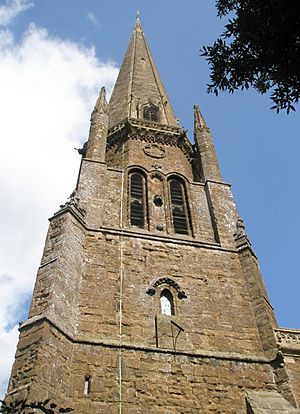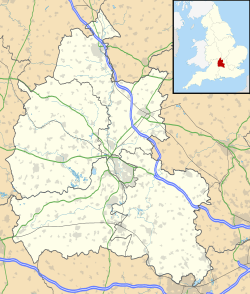St Mary's Church, Bloxham facts for kids
Quick facts for kids St Mary's, Bloxham |
|
|---|---|
| Our Lady of Bloxham | |

St Mary's steeple
|
|
| 52°01′04″N 1°22′29″W / 52.0179°N 1.3747°W | |
| Location | Bloxham |
| Country | England |
| Denomination | Church of England |
| Previous denomination | Roman Catholic |
| History | |
| Founded | 12th century |
| Dedication | St Mary the Virgin |
| Architecture | |
| Heritage designation | Grade I listed |
| Architect(s) | Original unknown Richard Winchcombe GE Street |
| Style | English Gothic |
| Specifications | |
| Materials | ironstone rubble |
| Bells | 8 |
| Administration | |
| Parish | Bloxham |
| Archdeaconry | Dorchester |
| Diocese | Oxford |
| Province | Canterbury |
St Mary's Church, also known as Our Lady of Bloxham, is a special church in the village of Bloxham, Oxfordshire, England. It belongs to the Church of England. This church is famous for its tall tower and spire, built in the 1300s. It is the highest church spire in all of Oxfordshire! St Mary's is also much bigger than most village churches. An expert on old buildings, Jennifer Sherwood, once called it "one of the grandest churches in the country." It is a Grade I listed building, which means it is a very important historic building.
Contents
Building St Mary's Church
How the Church Was Built
The first mention of a church in Bloxham was in 1067 AD. At that time, William the Conqueror gave the church to Westminster Abbey. However, the oldest parts of the church you see today are from the 1100s. These include pieces of stone from two doorways and parts of the chancel arch. The chancel is the area around the altar where the choir sits.
The rows of arches inside the church, called arcades, were built in the 1200s. This was when the original main part of the church, called the nave, was rebuilt. Most of the church we see now was built in the 1300s and 1400s. The chancel and the side sections, called aisles, were rebuilt in the early 1300s. The north and south porches were also added then.
During this time, the church was decorated with beautiful stone carvings. These included fancy window designs called tracery and detailed tops of columns called capitals. Many of these carvings are still there today. It is thought that skilled stonemasons, who also worked on nearby churches like Adderbury and Hanwell, created these designs. The tall tower was likely built between 1300 and 1340.
Inside the Church
You can still find small pieces of old Mediaeval wall paintings inside the church. One is a "Doom painting" above the chancel arch, which showed scenes of judgment. Another shows Saint Christopher above the north doorway. Some windows still have parts of their original stained glass from the 1300s. The church also has a very detailed screen, called a rood screen, from the 1400s. This screen used to separate the nave from the chancel.
In the 1400s, a new chapel was added to the south side of the church. It is called the Milcombe chapel. This chapel has a style of building called Perpendicular Gothic. We don't know who designed it for sure, but it might have been Richard Winchcombe. Inside this chapel, you can find monuments from the 1700s to members of the local Thornycroft family.
Modern Changes
From 1864 to 1866, the church was repaired and updated. This was done under the guidance of a famous architect named George Edmund Street. He made sure the spire was stable and added new features like the pulpit (where the priest gives sermons), choir stalls, and the reredos (a decorated screen behind the altar).
Later, in 1868, the artist Edward Burne-Jones created a stained glass window of St Christopher for the chancel. In 1869, William Morris, Edward Burne-Jones, and Philip Webb designed the beautiful east window.
In 2018, some old wooden benches, called pews, were moved from the church to create a play area for children. This caused a bit of a problem because the church needed special permission from the Diocese of Oxford to do this. An organization called the Victorian Society said the pews were not stored well and were getting damaged. In the end, the church was allowed to keep the play area, but four of the pews had to be put back into the church.
Church Bells
The church tower has a set of eight bells that can be rung together. The fifth bell was made around 1570. The largest bell, called the tenor bell, was made in 1648. Another bell was made in 1750. The other four bells were made in 1903. These bells are the heaviest set of change-ringing bells in the world that are rung from the ground floor inside a church!
The church also has two smaller bells. One is a Sanctus bell, made around 1599. The other is a service bell, made around 1899.
Who Owned the Church?
In 1067, William the Conqueror gave the church and its land to Westminster Abbey. But in the 1100s, King Henry II gave the right to choose the church's priest to Godstow Abbey. This made Westminster Abbey unhappy, and they complained to the Pope. However, the Pope allowed Godstow to keep the church as long as they paid Westminster Abbey every year.
When King Henry VIII closed down the monasteries in the 1530s, the right to choose the priest for Bloxham church went to the King. In 1547, the King gave this right to Eton College.
The church has a large graveyard around it, which has been made bigger several times over the years. Schools in Bloxham use the church for their Christmas services each year. Today, St Mary's is the main church for the area, which also includes the villages of Milcombe and South Newington.



